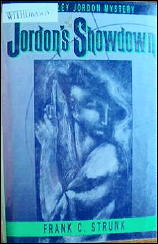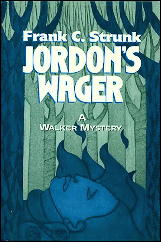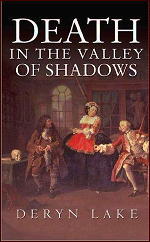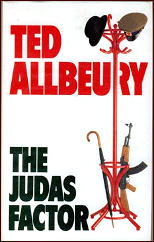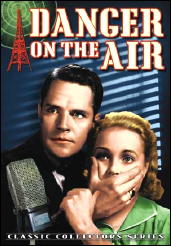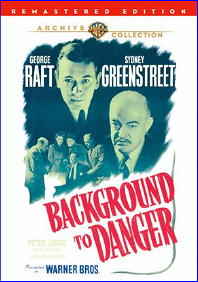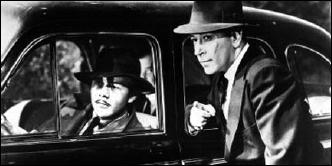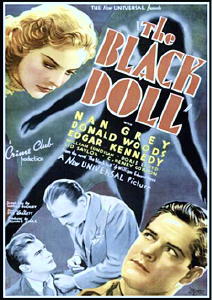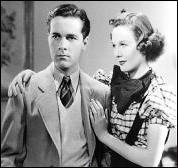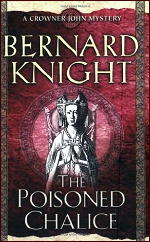A REVIEW BY CURT J. EVANS:
CAROLYN WELLS – The Umbrella Murder. J. B. Lippincott, US/UK, hardcover, 1931.
Some enterprising satirist should put Raymond Chandler’s Philip Marlowe in a Carolyn Wells’ mystery novel. Given Chandler’s scathing disdain for the rich and socially connected and Wells’ disproportionate admiration for them, the resulting clash of temperaments would be interesting.
In 1931, Dashiell Hammett was making the “hardboiled” style appetizing in the United States, but unflappable Carolyn Wells breezed right on in her usual manner, seemingly oblivious to new trends in crime (though, interestingly, she included Hammett stories in her mystery tale anthologies). The Umbrella Murder sees foul death strike at a fashionable Club Spindrift in coastal New Jersey.
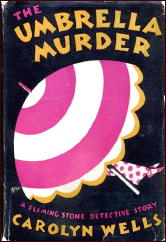
“Neither effort nor expense was spared to make the best and most elaborate beach resort in the country,” reports Wells breathlessly. “The Clubhouse was a gem in itself, and the Casino was another. It was all exclusive, and expensive.”
You might think that someone is murdered with an umbrella at Club Spindrift, but, ha, if so, Wells has fooled you. It seems that wealthy and beautiful heiress Janet Converse has been dispatched with a poisoned syringe while sitting under a beach umbrella, clad in her gaily striped beach pajamas, this season’s “IT” fashion trend (disappointingly, the splendid art deco dust jacket shows the expired Janet clad in polka dot pajamas — given the amount of time Wells devotes to describing the beach pajamas worn by Janet and the girls in her “crowd,” you would have thought cover artist Irving Politzer would have gotten this detail right!).
At one time there were about twenty people, all Janet’s crowd, gathered under the umbrella, so I was wondering whether “The Beach Tent Murder” might have been a more accurate title. Hey, you have to occupy yourself somehow when reading a Carolyn Wells mystery (incidentally, the umbrella on the dust jacket simply could not have afforded shelter to that many people).
But, anyway, Fleming Stone, you may not be surprised to learn, was on the beach; and he soon is pulled into the case, the locals being jaw-droppingly incompetent. It takes Stone, who has horned in on the autopsy, to discover the “minute puncture” on Janet’s left hip. The Great Detective knows what to do next:
“Now, if one of you doctors will cut into the heart, the upper part, and be quick to note any odor–“
“My God!” exclaimed Cutler, “you don’t mean–”
But the coroner made the incision advised by Stone, and immediately both he and Cutler were conscious of a faint smell of bitter almonds:
“Prussic acid!” Cutler cried….
After this interesting scene, the police are obliged to investigate Janet’s crowd, though they have trouble believing the murderer could be one of those “rollicking youngsters,” naturally popular and beloved by all on account of their good looks, stylish clothes, fine breeding and lavish living.
As one man avows: “Those girls are as handsome as any I ever saw, and the boys are thoroughbreds.”
Unfortunately, compounding the disturbing social scandal, a diamond necklace Janet was carrying in a pocket of her beach pajamas (don’t ask) has disappeared, apparently stolen. Worst yet, suspicion starts to center on Janet’s fiancee, Stacpoole Meade, one of the richest of this rich set (his father is Stuyvesant Meade, so that should tell you something).
Surely a son of Stuyvesant Meade couldn’t be involved in murder and theft?! Thankfully, Stacpoole Meade manages to prove his innocence when he gets murdered too.
Meanwhile, back at Janet’s home, a mock castle overlooking the beach named Twin Turrets, Janet’s aunt and heir, spinster Jane Winthrop, is having to deal with an apparent apparition haunting one of the aforementioned turrets, demanding the return of its “treasure.” Fortunately Aunt Jane has a staunch friend in her Irish housekeeper, Molly Mulvaney, who, just to make sure the reader knows she is Irish, says things like this:
“Mercifulation! What a coil! Not only is the poor darling dead, but all the kickooin’ there”ll be straightenen’ of it all out.”
Then Aunt Jane disappears, seemingly kidnapped, perhaps murdered. And a distant cousin shows up to claim the estate (assuming Aunt Jane is dead too). And a strange elderly detective, Humphrey Holt, appears on the scene as well, announcing he wants to help Fleming Stone crack the case. Fleming Stone has his hands full with this one!
WARNING: FURTHER DISCUSSION OF THIS SPLENDID LOOPINESS OF THIS TALE NECESSITATES THE INCLUSION OF MAJOR SPOILERS CONCERNING THE SOLUTION
I’m certain you’ll be amazed as I was to learn that Fleming Stone reveals that Humphrey Holt is really Aunt Jane in disguise! Why did Aunt Jane disappear to do a drag routine? Well, let Aunt Jane explain it herself:
“[T]he only way I could get Janet’s murderer was to pretend to be a detective and so have an opportunity to investigate. Also, I must pose as a man, for a woman detective is no good, and too, I’d be recognized.”
So the intrepid Aunt Jane plucked her bushy eyebrows, “had a new double set of false teeth made” (quick work!), “got her hair shingled and thinned out” and had her brother, with whom she was staying, coach her “in the matter of manly action” (I told you, don’t ask). And she was able to fool everyone in town once she returned, except Fleming Stone, of course.
I’m sure this makes perfect sense to you too.
The most astounding revelation of all, however, is that the murderer turns out to be Janet’s best friend, that beautiful blonde, Eunice Church. We learn to our horror that Eunice is “almost, if not quite, insane” and that she killed Janet and Stacpoole out of jealously over their engagement. After Eunice dispatches herself with another hypodermic syringe (such handy things), Fleming Stone is left free to explain his brilliant deductions to the surviving characters:
“Perhaps you’ve noticed [Eunice’s] mannerism of tucking her thumbs into her curled fingers… That is a sure sign of weakness of character, degeneracy, and even criminal tendency. Then, her head is flat at the back. That is positive proof of hatred, revenge and jealously….[And her ears are] pointed at the top, [with] broad and heavy lobes, and a thin helix…It all points toward a criminal nature… Then her thin lips, her eyes, steel blue at times, though often violet, and her prominent muscular jaw, in spite of her soft chin, all meant homicidal mania that was sure to break out upon provocation.”
Wow! Clearly Eunice should have been drowned at birth. Unfortunately for her criminal schemes, she failed to consult Aunt Jane in disguise techniques, and she fell under the the penetrating gaze of Fleming Stone, an obvious student of physiological criminologist Cesare Lombroso.
How any of this is really fair play detection I don’t see, but apparently Carolyn Wells’ fans were more interested in the details on those smart and fashionable beach pajamas.
One thing I will say in this tale’s favor: Eunice’s hiding place for the stolen diamond necklace (well of course she perpetrated that too — heck, if she hadn’t been stopped cold by Fleming Stone, we probably would be reading about “Eunice and Clyde” today) is quite clever, and reminds me of certain stunts by Dorothy L. Sayers and John Dickson Carr (an adolescent admirer of Miss Wells). I won’t spoil that part!
The rest is purest Gun in Cheek material. The reader is warned.
Editorial Comment: One of the books by Carolyn Wells that Curt has reported back on in recent weeks, and much more favorably, was The Furthest Fury. You can read his review here.
